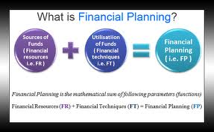Numbers, figures, decimal points and dollar signs. Those are the key factors that will pop up from the page into the line of sight of the average person who reviews the financial side of your business plan. However, it is important to realize that there is a method to the numerical madness which must be made into a top priority. You can follow several simple steps that will make it possible for you to develop the financial section in a way that will effectively breathe life into your business plan overall.
Understand the Purpose of the Section
Beneath all the figures and calculations that will be reflected within the financial section of your business plan, you need to be able to clearly identify its specific purpose. The purpose and target objective of this section goes far beyond simply showing how much money you plan on spending and hopefully making at some specified point in the foreseeable future. There are actually two separate purposes that are fulfilled by this one section.
When you search for investment opportunities that are offered by venture capitalists, clever investors or even intelligent friends and relatives, you are going to need to be able to show them this financial reflection and projection. At the other side of the spectrum is the need to benefit from this financial forecast for your own personal and professional needs and expectations.
A well-developed financial plan will make it much easier for you to have a clear and concise perspective of how your business has done, is doing, and will do in the future. Instead of spending a considerable amount of time digging through seemingly endless piles of paperwork and forms, you will be able to have a quick point of reference that is readily available for review whenever the need for it arises.
Differentiate this Section from Accounting Reports
As you are working through the accounting section of your business plan, you have to keep close in mind the simple fact that it is absolutely not like the accounting reports that you generate on a monthly or even weekly basis. Many people seem to forget that there is a major difference between those reports and the financial aspect of your business plan. First and foremost, those reports deal directly with the past (i.e. historical data, past cash flow statements, etc.)
On the other hand, the financial section of your business plan needs to focus more on the future. While it is necessary for your plan to at least address the financial past of your company, it needs to focus primarily on the future. Cash flow projections, estimates, and an overall forecast of the financial future will serve as the major building blocks and core elements of your plan. If you are not able to clearly distinguish between your accounting reports and the financial layout of your business plan, you need to go back to the drawing board and see where everything went wrong.
Create a Solid Sales Forecast
The best approach to take would be to focus on developing a solid sales forecast first before you dive into any other calculations and figures. A general rule of thumb is to simply create a record or spreadsheet that documents your sales projections for the next three to five years. Make sure that you have it sectioned off and categorized so that the person reviewing this part of your plan will easily be able to see everything they need, according to the Small Business Administration. The sales forecast will then make it much easier for all of the other puzzle pieces to fall into place primarily because the sales forecast will serve as a major cornerstone of its development.
Don’t Forget About the Expenses
While you are developing the financial section of your budget, make sure that you do not place too much focus on the green side of your calculations. Watching how quickly your figures will add up can become very mesmerizing and even hypnotizing, especially if you are fairly new to the world of business in general.
However, it is important for you not to allow these figures to cause you to lose focus and drift away. You need to also make room for expenses in those projections by developing a detailed expense budget. Your expense budget should cover everything – fixed costs and variable costs alike. Make sure that you focus primarily on developing a future forecast instead of duplicating your past accounting reports, though.
The Bottom Line
The financial section of your business plan needs to become much more than just figures and dollar signs. It needs to become a clear and concise reflection of the foundation of your business. When developing this section, you will pay tribute to the past by shining a light on where you have already gone. However, your financial plan will actually become a shining beacon that will illuminate the path to success on which your company will travel into the future.

Leave a Reply